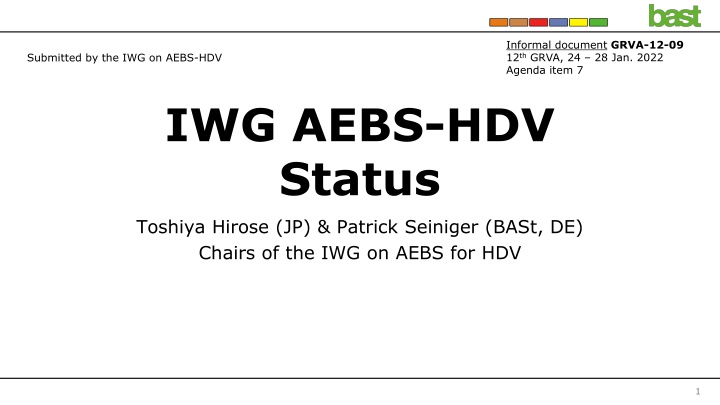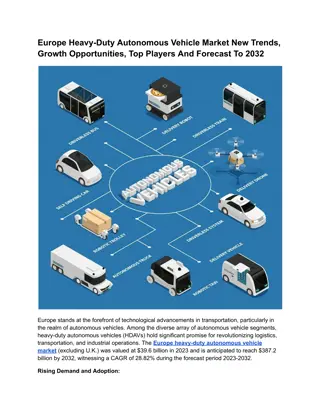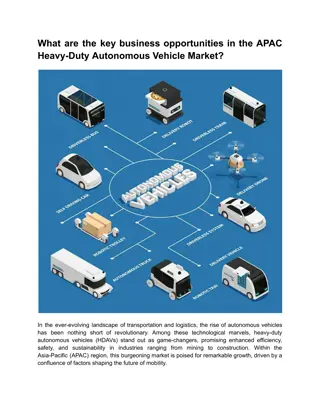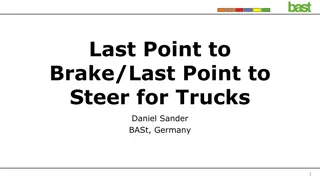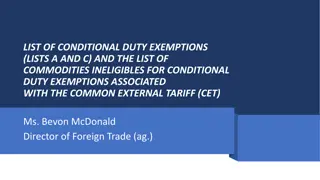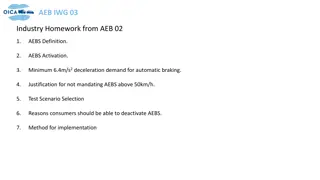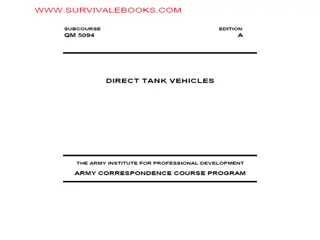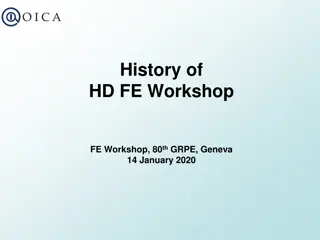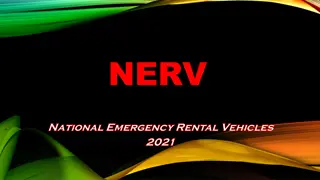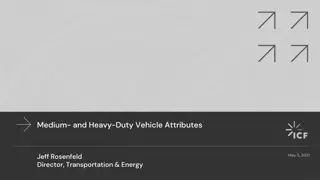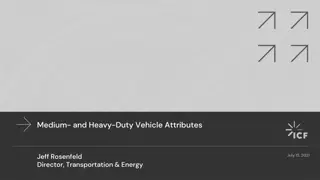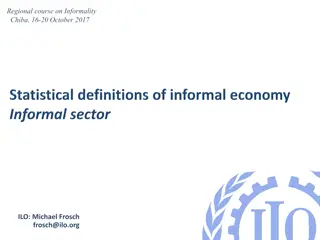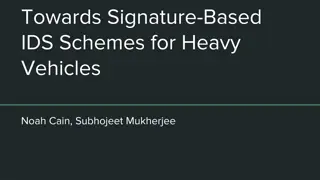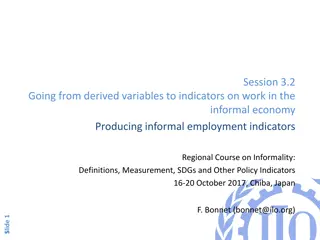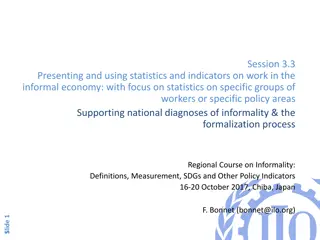Update on Informal Working Group Activities for AEBS in Heavy-Duty Vehicles
The Informal Working Group on AEBS for Heavy-Duty Vehicles has made significant progress in developing a draft regulatory proposal to revise UN Regulation No. 131. Key tasks include assessing accident situations, exploring a generic marker triggering AEBS, defining performance requirements, and more. New concepts such as AEBS deactivation procedures specific to heavy vehicles have been discussed. The group aims to enhance safety standards for heavy-duty vehicles through collaborative efforts and innovative solutions.
Download Presentation

Please find below an Image/Link to download the presentation.
The content on the website is provided AS IS for your information and personal use only. It may not be sold, licensed, or shared on other websites without obtaining consent from the author.If you encounter any issues during the download, it is possible that the publisher has removed the file from their server.
You are allowed to download the files provided on this website for personal or commercial use, subject to the condition that they are used lawfully. All files are the property of their respective owners.
The content on the website is provided AS IS for your information and personal use only. It may not be sold, licensed, or shared on other websites without obtaining consent from the author.
E N D
Presentation Transcript
Informal document GRVA-12-09 12thGRVA, 24 28 Jan. 2022 Agenda item 7 Submitted by the IWG on AEBS-HDV IWG AEBS-HDV Status Toshiya Hirose (JP) & Patrick Seiniger (BASt, DE) Chairs of the IWG on AEBS for HDV 1
Introduction Informal Working Group on AEBS-HDV was initiated by GRVA in September 2021 ToR requests an updated regulation per GRVA in February 2022 ECE/TRANS/WP.29/GRVA/2022/7 GRVA-12-08, containing corrections and the following: Specifications on deactivation of the AEBS Text on requirements and reference to test section Introduction text Final open issue: Transitional provisions 2 Toshiya Hirose & Patrick Seiniger
Current Status of IWG (accomplished, open) IWG had 9 meetings (last meeting: January 11/12) Main task: develop a draft regulatory proposal to revise UN Regulation No. 131 a) Assess the accident situation for heavy duty vehicles b) Investigate the feasibility of a generic marker triggering AEBS c) Define state of the art performance requirements d) Review the values for the target speed reduction for M2and N2 e) Review AEBS on V2Car, V2Ped, V2Bicycle, others f) Incorporate as relevant new concepts from UN Regulation No. 152 Marker Triggering AEBS TNO/NL conducted a study, feedback loop in IWG expected Presentation for May GRVA foreseen slight extension of mandate? 3 Toshiya Hirose & Patrick Seiniger
Recap: Performance (from GRVA11) AEB Vehicle- Vehicle AEB Vehicle- Bicycle Vehicle category AEB Vehicle-Pedestrian Hydraulic braking (R152 as alternative) derived from M1N1 50 km/h 26 km/h - (no systems) M2 M3, N2 <= 8t Hydraulic braking (R152 as alternative) 35 km/h 20 km/h - (no systems) others 70 km/h 40 km/h (urban) Pneumatic braking 20 km/h - (no systems) N2 > 8t M3 > 8t N3 70 km/h 40 km/h (urban)* 20 km/h - (no systems) This is relative speed v0,Ego-v0,Target, up to which avoidance would be required. Mitigation speeds also required, comparable to R152 No differentiation Moving/Stationary Ambition for higher values and AEB Vehicle-Bicycle is expressed in a preamble. 4
New Concepts in Informal XXe (1) Deactivation of AEBS The group was of the opinion that heavy vehicle operations are different than M1-N1 and that the following methods are better suited for those vehicles than simply aligning with UN R152: When deactivated manually, AEBS will reactivate again after 15 min A more complex deactivation procedure for longer deactivation after possible sensor damage is allowed AEBS deactivation (e.g. in workshop), e.g. to be able to use front- mounted equipment, persistent over ignition cycles In this case, AEBS deactivation will be indicated for at least 15 secs after operation of the vehicle master control switch 5 Toshiya Hirose & Patrick Seiniger
New Concepts in Informal XXe (2) Definition of performance requirements Group agreed on a structured list vehicle external influences allow for the required deceleration (exhaustive list included) the vehicle state itself allows for the required deceleration (list of examples included) there are no external influences affecting the physical sensing capabilities (exhaustive list included) the situation is unambiguous (exhaustive list included) New wording after list: When conditions deviate from those listed above, the system shall not deactivate or unreasonably switch the control strategy. This shall be demonstrated in accordance with chapter 6 and Annex 3 of this Regulation Suggestion to align R152 with a supplement 6 Toshiya Hirose & Patrick Seiniger
New Concepts in Informal XXe (3) 5.2.1.2. When the system has detected the possibility of an imminent collision, there shall be a braking demand of at least 4 m/s to the service braking system of the vehicle. This does not prohibit higher deceleration demand values than 4 m/s during the collision warning for very short durations, e.g. as haptic warning to stimulate the driver s attention. The emergency braking may be aborted, or the deceleration demand reduced below the threshold above (as relevant), if the conditions prevailing a collision are no longer present or the risk of a collision has decreased. This shall be verified according to paragraphs 6.4. and 6.5. Emergency braking 6.4 Warning and Activation Test with a Stationary Vehicle Target [ ] If this is deemed justified, the technical service may test in any test condition within those specified in paragraph 5.2.1.4., any other speeds listed in the tables in paragraph 5.2.1.4. and within the prescribed speed range as defined in paragraph 5.2.1.3. The Technical Service may verify that the control strategy is not unreasonably changed or the AEBS switched off in other conditions than those specified in paragraph 5.2.1.4. The report of this verification shall be appended to the test report. Examples same changes in 5.2.1.1., 5.2.2.1., 5.2.2.2., 6.5., 6.6.1. (also sugg. to align R152) 7 Toshiya Hirose & Patrick Seiniger
Open Issues Transitional Provisions Position of OICA/CLEPA: September 2025 / September 2028 Development time needed (esp. AEB-City new system!) Synchronization with vehicle modifications already addressing VRUs, due to GSR (in EU) Implementation not before 09/2025, for an adoption at this GRVA-12 (acceptable to keep the same date even with adoption at next GRVA) Position of Japan: May 2025 / September 2028 When R131-02 adopted today, Industry would have 28 Month Proposal of Germany, ETSC: Split AEB-Vehicle & AEB-Pedestrian Changes in AEB-Car important for Safety & state of the art This could be introduced much earlier Split of document to R131-02 and R131-03 required in this case Request to GRVA for decision 8 Toshiya Hirose & Patrick Seiniger
Summary All remaining issues were solved in the IWG s final meeting, except for the definition of transitional provisions After a decision from GRVA, the new revision of UN R131 would be ready for adoption Remaining tasks: Feasibility of marker to trigger AEB intervention presentation planned for GRVA-13 (if mandate slightly extended) Suggestion to align R152 (definition of performance requirements), possibly inviting R152 experts GRVA is kindly asked for an extension of mandate until GRVA 13 9 Toshiya Hirose & Patrick Seiniger
